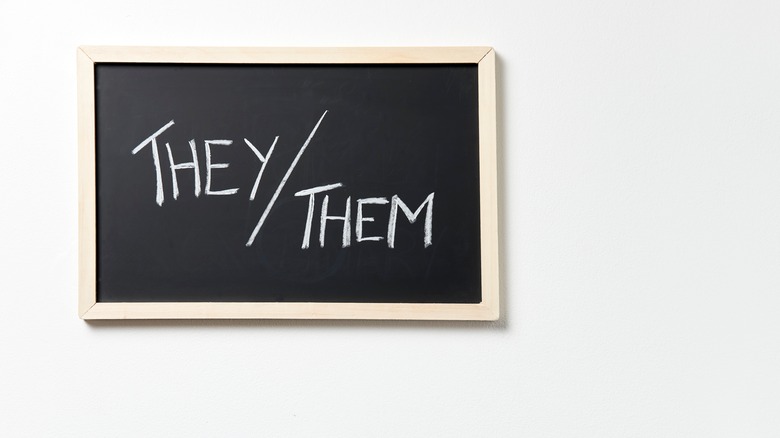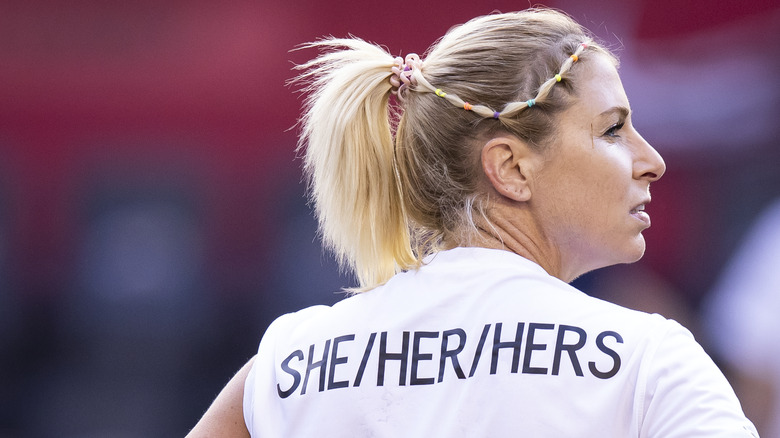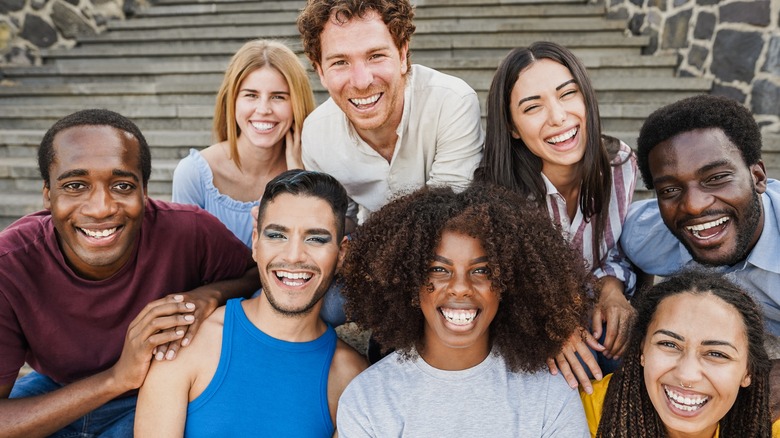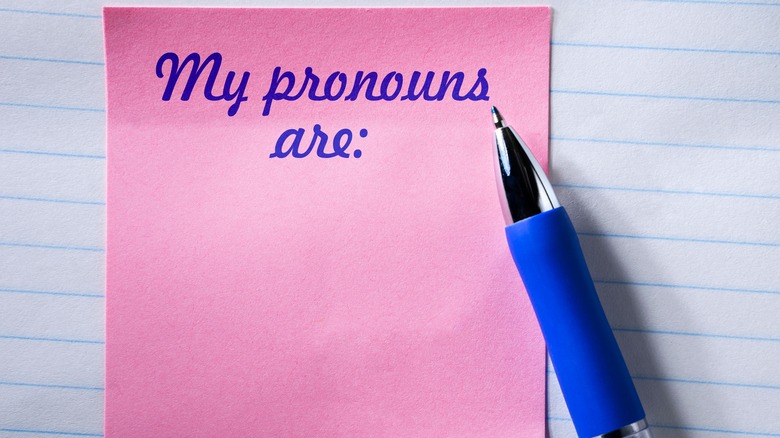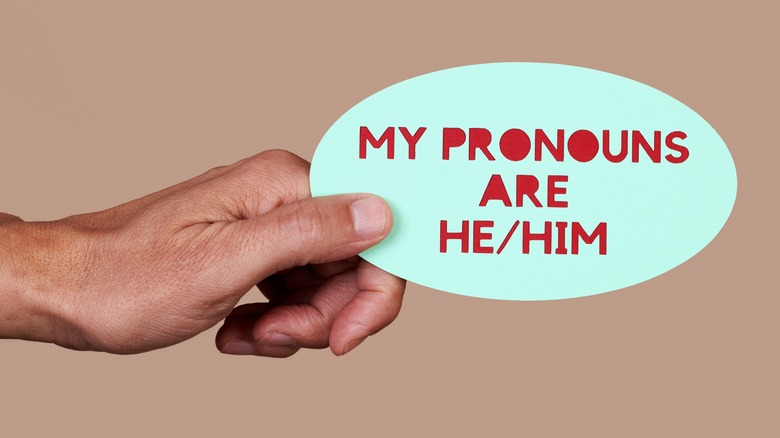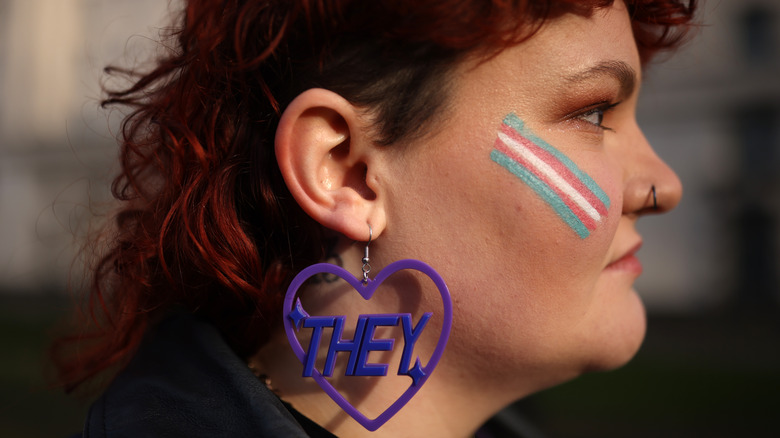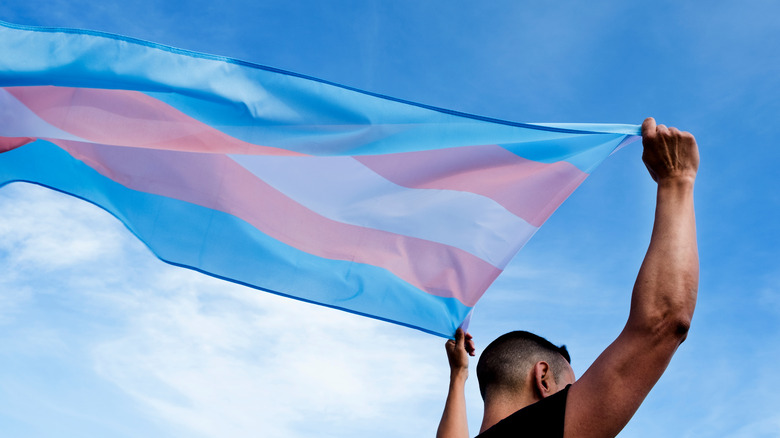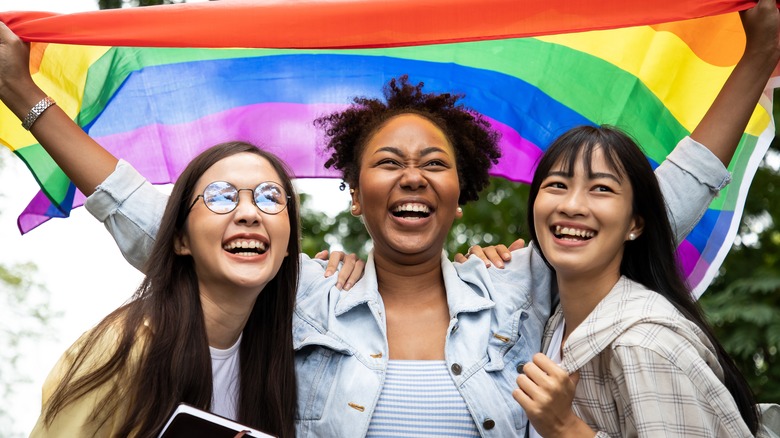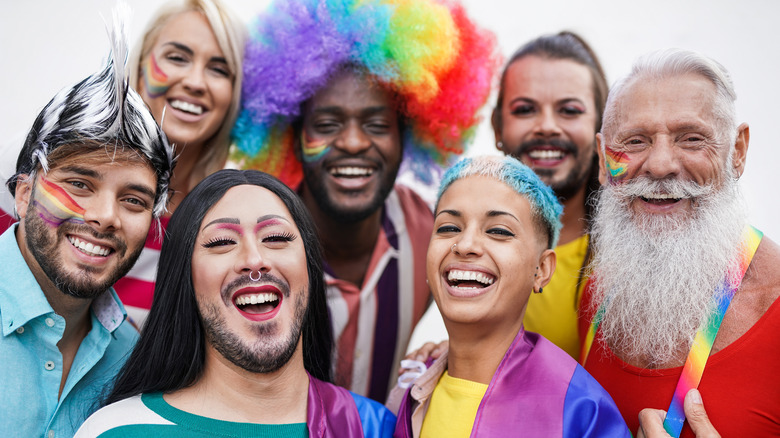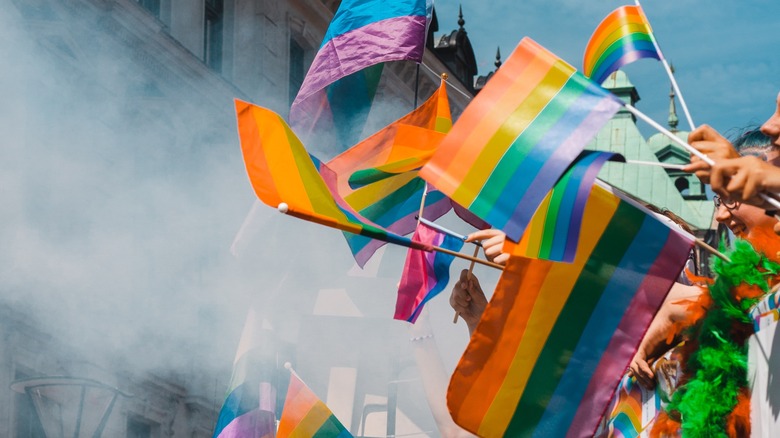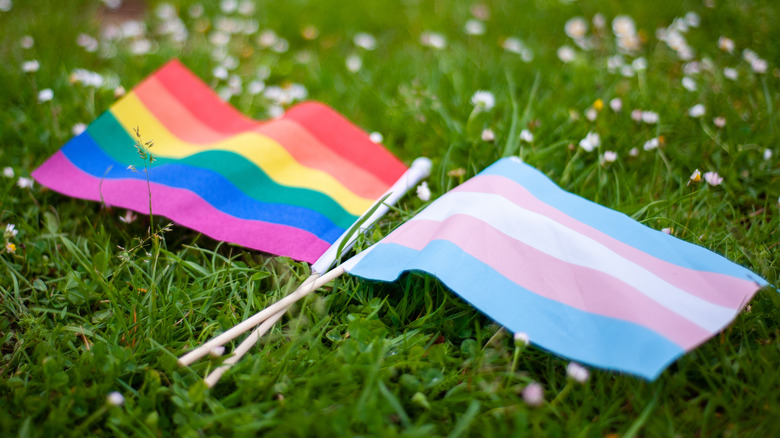Gender-Neutral Pronouns: Your Guide To Getting It Right
"Pronouns are basically how we identify ourselves apart from our name. It's how someone refers to you in conversation. And when you're speaking to people, it's a really simple way to affirm their identity," Mary Emily O'Hara, a communications officer at GLAAD, explained while discussing pronouns with NPR. Pronouns have been around almost as long as language itself, which means assuming someone's gender and subsequent pronoun choice has too. That can cause a number of issues though, as more and more people are open about not identifying with the sex they were born or feel they exist outside of the traditional cis male or cis female parameters. Of course, now we know that gender is a spectrum, and there are a whole array of pronouns to best describe people within the LGBTQ+ community beyond the traditional femme she/her and masculine he/him.
The pronoun concept is becoming increasingly important, as 2021's Bigeye National Study found that 27% of respondents who belong to Generation Z claimed they have a friend who identifies as being transgender. Equally, 23% have a friend who identifies as being either nonbinary or gender non-conforming, while 14% of those asked explained they had a friend who identifies as genderfluid. That's a whole lot of people for whom the traditional he/him or she/her just don't fit.
Why gender-neutral pronouns are necessary
People choosing the pronouns that best fit them happened because they felt the traditional he or she did not represent them — and everyone deserves to feel acknowledged and understood. University of Illinois professor emeritus of English, Dennis Baron, explained why so many people opt for different pronouns to the College of Liberal Arts & Sciences in 2020. "The pronoun is becoming like an honorific, like a title. This is how you refer to me. It's got this extra-special significance once again in the context of new gender issues," he shared. "It's not just women's rights; now it's trans rights and nonbinary rights. We see a revived interest in both coined pronouns and the singular 'they.'"
When a person identifies the way they see fit, it allows them to feel seen in an environment that historically hasn't been LGBTQ+ friendly. "Using the correct pronouns for trans and nonbinary youth is a way to let them know that you see them, you affirm them, you accept them and to let them know that they're loved during a time when they're really being targeted by so many discriminatory anti-trans state laws and policies," Mary Emily O'Hara explained to NPR.
As the LGBTQ+ community becomes more visible and those who don't feel they fit into stereotypical genders feel more comfortable being themselves, that meant there was a need to create new terminology for them to properly identify with.
How did people changing their pronouns come about?
Including different pronouns in how we refer to people has actually been around longer than people may think. It was back in the mid-19th century when the concept started to rise to prominence, as, in 1884, the pronoun thon was a common term used in North America to refer to all genders, according to AP. But the concept didn't exactly last too long everywhere in the western world. In 1850, the British Parliament determined that it was acceptable to use masculine terms to refer to anyone of any gender, which pushed back the pronoun movement. At the time, the issue was based more around women's liberation as many feminists were pushing for a change to reflect how men and women were referred to.
The pronoun concept then rose to prominence once again as the world started to recognize in more modern times that gender is not as simple as male or female. As Dennis Baron explained to the College of Liberal Arts & Sciences, "The debate has been re-energized in the last 15-20 years because of awareness of nonbinary gender issues and transgender and gender-nonconforming people."
Gender neutral pronouns you need to know
He/him and she/her are the two most commonly known pronouns. He, of course, refers to someone who identifies as male, she is used for someone who identifies as female, and they often refers to those who prefer not to identify solely with the two typical genders. People who may prefer to use the pronoun they may also identify as non-gendered, nonbinary, genderfluid, while there are plenty outside of those groups who just feel more comfortable avoiding the more traditional terms. But they aren't the only pronouns you need to know to make sure you're being fully inclusive.
To make sure you're really looking out for everyone's needs, it's a good idea to keep a number of other pronouns in your vocabulary. Ze and xe, come under the umbrella of the term neopronouns and are interchangeable. Either can be used instead of she, he, or they. There's also the neopronoun hir, which can be used instead of her, hers, him, his, they, or theirs. Some people also prefer to use the pronoun Ey, which is also a shortened version of they, while Mx is also often used instead of Ms., Mrs., Miss, or Mr.
Pronouns are changing and developing all the time, so it's important to keep up to date with the latest developments via outlets like LGBTQ Nation to ensure you're aware of the terms and what they mean.
What is a neopronoun?
The term neopronoun is a new (neo literally means new!) take on the more traditional pronoun, which aims to be even more inclusive. Neopronouns have become increasingly common to acknowledge that there are people who don't fit into the he/she/they categories, as that suggests there are only three gender categories. Of course, we know that in reality, there are plenty more.The reason why we need so many pronouns and it's essential we're open to many more being created is because, as Mickey Elliott explained to Zurich, "People can use she-her or he-him pronouns and still identify as nonbinary — a 'they' pronoun is not a prerequisite." In essence, there are no hard and fast rules as to who chooses what pronoun based on the way they identify.
Yet, often, society has pre-existing views regarding a person's gender based upon the pronoun they choose, so the more new words we can incorporate into our vocabularies without those pre-existing notions, the better! Stefanie Juliano, a licensed clinical professional counselor, explained the origin of the neopronoun ze to Cosmopolitan, sharing, "Ze felt like it was associated with the presence of another gender besides male/female rather than just the neutrality of gender. It is sort of like having the options on a gender list saying male, female, nonbinary, or genderqueer instead of listing only male, female, or 'other.'"
Why using someone's preferred pronoun is so important
We know that adapting to someone's pronoun choice is important, but why exactly is it so very important? Alex Schmider, associate director of transgender representation at GLAAD, explained the significance to NPR, noting that using the term someone has chosen from themselves is "a way of respecting them and referring to them in a way that's consistent and true to who they are." It may seem like a simple change to a cis person (that's the term used for a person whose gender identity matches the sex they were born into) but it can be a way for an LGBTQ+ to feel more understood, included, and confident. It's also one of the most basic ways a person can show respect who may be a little different to them, which is what makes the world go round, right?
To some people, the whole concept may seem insignificant and even trivial, but, as Dr. Marie-Claude Gervais, Director of Research at Versiti, explained during a 2020 episode of "In Clear Focus," it can have a much bigger impact beyond just saying a word — even on cis people. "People who belong to minority groups are particularly interesting because if you understand their needs, you get things right for the majority of the population as well," Gervais shared. "Getting things right for a minority can really serve the needs of a majority."
When to use the term they
Some people may identify by using more than one pronoun, which may, on the surface, seem a little confusing. One such example is those who use a more gender-specific she or he as well as the term they, which may look like she/they or he/they when written down. In this case, you may have a few questions. Like, when should you use the they pronoun and is it okay to still say he or she?
Well, take this as your chance to mix it up! In a lot of cases, people who identify as she/they or he/they do so because they want to be acknowledged as both, so the most respectful thing you can do is use both. The same can usually be said for people who choose any collection of pronouns. As Deputy executive director of the National Center for Transgender Equality, Rodrigo Heng-Lehtinen, explained to NPR, using both will do a lot more than you may realize. It shows you're taking into account they've made a point of telling the world they like both terms, and it will also show you've taken the time to research their choice.
If you find yourself struggling to know how to properly use any pronouns, there are ways to learn how to be more inclusive. There are numerous online resources, including Minus18's pronoun tool which explains the subject, object, possessive, and reflexive versions of each pronoun, while also providing examples of how to use them.
How to ask a person's pronouns the right way
The very best way to make sure you're addressing everyone how they want is to keep it simple and ask. It's as simple as that! "It may feel awkward at first, but eventually it just becomes another one of those get-to-know-you questions," Mary Emily O'Hara admitted to NPR. Always make sure you're asking the question alongside a caveat, though, to make sure nobody feels forced to define themselves in a way they may not want to. For example, you may want to phrase the question like, "Can I ask your pronouns, if you feel comfortable?" so you're allowing people to only share if they want to. If someone doesn't want to divulge their pronouns for whatever reason, it's more appropriate to ditch the pronouns entirely and use their name only.
To make it a little easier for everyone, it may help to get into the habit of introducing yourself by sharing your pronouns first to make people feel more comfortable sharing theirs. The best way to approach asking someone for their pronouns is also by avoiding suggesting options before they speak. So, don't ask, "Should I call you he or she?" Instead, give them space to explicitly tell you exactly what they prefer without feeling they have to fit in with one of your suggestions. As we know, guessing can often come across as rude in itself, and the person may even identify with a pronoun you haven't heard of.
Not everyone has a pronoun and people's preferences can change
While there are lots of gender-neutral pronouns available, it's important to take into account that not everyone identifies with one. Gender Inclusivity diversity trainer Debi Jackson suggested to Cosmopolitan that, if you encounter someone who prefers not to use a pronoun, avoid using any and instead refer to them by their chosen name. "It takes some effort to structure sentences without the use of a pronoun, but it can be done," Jackson shared, noting it's better to say a clunky sentence using only a name than risk offending someone.
It's also worth keeping into account that people's pronouns may change. Someone may identify with a particular pronoun at one point in their life, but later feel closer to another. While people, in a lot of cases, will tell you if they've changed their pronoun, it's still worth checking in every now and then if you're unsure. "We have to trust that people will use the pronouns that feel best for them and not question it. And if later down the road, those pronouns change, then the new pronouns should be adopted," author Iris Gottlieb told Cosmopolitan, noting an open mind is imperative when it comes to pronoun usage. "We all want people to respect our gender identities and expressions and asking for pronouns is a simple way to gain information to better understand one another and ensure we address each other in a way that feels good," Gottlieb added.
The repercussions of getting it wrong
Continually using the wrong pronouns, even if it's accidental, can sometimes be viewed as a microaggression and an attack against the LGBTQ+ community. A 2018 study found in Stigma and Health that when people are misgendered, particularly on a regular basis, they feel invalidated and unseen. The more being misgendered happens, the more of a detrimental effect it can have on a person's mental health.
Zil Goldstein, associate medical director for Transgender and Gender Nonbinary (TGNB) Health at Callen-Lorde Community Health Center, explained what being misgendered is actually like to Health. "When I'm explaining it to people, I like to say it's like being slapped on the cheek. If it happens once or twice, it stings for a moment. But then, you feel better," Goldstein shared. "But if you're getting slapped multiple times a day from multiple people — sometimes with random people coming up to you on the street and slapping you in the face — it's going to get more painful and more upsetting as time goes on."
So, think of doing your best to get people's pronouns right as your way of making the world a slightly better place, all with minimum effort. Win-win, right?
What to do if you get someone's pronouns wrong
Like with anything that feels new and different, it can be easy to make a mistake when it comes to pronouns and misgender someone without even realizing. But a genuine apology before learning from your mistake and trying harder next time is the only way to ensure the concept feels more natural for everyone and eventually becomes like second nature.
Rodrigo Heng-Lehtinen explained to NPR that a lot of people will get things wrong in the early days. So there's no reason to beat yourself up if it's a genuine mistake that you then learn from. "I think it's perfectly natural to not know the right words to use at first. We're only human. It takes any of us some time to get to know a new concept. The important thing is to just be interested in continuing to learn," he shared. Heng-Lehtinen recommended apologizing to the person you misgendered, but don't make a big deal about the mistake. By repeatedly apologizing or making a bigger deal out of what happened, you may only end up drawing more attention to someone who didn't want it in the first place. "Doing that really simple gesture of apologizing quickly and moving on shows the other person that you care. And that makes a really big difference," he added.
Take a stand
One of the best ways to support the LGBTQ+ community and the concept of pronouns is to speak up. No matter what the situation. Of course, ensuring you're always using someone's preferred pronoun is the best way to show your support, but it's just as important to be vocal if you see someone being misgendered or someone refusing to acknowledge someone's chosen pronouns as well.
If you're in a social or work environment and someone calls someone else the incorrect pronoun, in a non-confrontational way, speak up and correct the mistake maker about the preferred pronoun. Not only will that show the person who's been misgendered they're being supported in a public way, but the person who made the mistake will also be more likely to remember their chosen term for next time.
Helping educate those who are yet to recognize gender-neutral pronouns or don't see the importance of them is equally important. Pass along articles like this one to those who aren't educating themselves on pronouns, or direct them to important resources like LGBT Foundation, where members of the LGBTQ+ community share their stories.
Make your language more inclusive
There are several ways to make your language less offensive to those around you, simply by making just a few small changes to the way you speak. One of the best ways to make everyone feel included while avoiding misgendering people is by taking gender out of your vocabulary, particularly in group situations or circumstances where you don't know everyone too well. For example, instead of assuming everyone's gender and saying, "Hey, guys!" or "Hi, ladies!" try out a broader "Hi, everyone!"
If you're in a situation where you find yourself speaking in front of a group and aren't in a position to ask everyone their chosen pronouns individually (you may be giving a presentation at work, for example), the best way to make sure you avoid causing offense is to default is to gender-neutral pronouns from the start. Rely on using people's specific names and stay away from generic phrases like "ladies and gentleman" which may seem inoffensive on the surface, but can actually cause many people to feel excluded and alienated.

